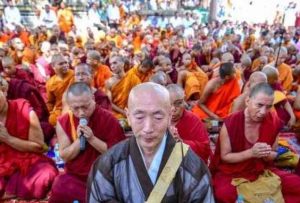
The Inaugural International Forum on Tiantai Studies—the first of its kind—was held at The University of Hong Kong from 17–18 October 2019. While it was dominated by monastic and academic speakers from mainland China and Taiwan, Brook Ziporyn, professor of Chinese philosophy, religion, and comparative thought at the University of Chicago Divinity School, was also present to give a keynote. “I felt it incumbent upon me to attend. I felt it was a great opportunity to have a mixed-language event like this, in a perfect international nodal point like Hong Kong, in the hopes of perhaps sparking greater knowledge of Tiantai, and the work being done in all languages, among Buddhist and non-Buddhist communities in both Chinese-speaking and English-speaking scholarly and practitioner communities,” he shared.
Tiantai is better known as Tendai in Europe, as the Japanese expression of this tradition has a small number of ordained priests based in countries such as Denmark, including Rev. Shomon of the Tendai Dharma Center north of Copenhagen. The earlier China-based tradition is not so well-known. “Tiantai is not famous in Anglophone scholarship or Buddhist culture, being far overshadowed by Chan or Zen, Tibetan traditions, and Theravada in the West,” said Prof. Ziporyn. “This is partly because both its practices and its textual sources are very complex and expressed in forms that do not lend themselves readily to translation, partly because its ideas are among the most radical and counterintuitive among the Buddhist traditions.”
When Prof. Ziporyn first started out on his Buddhist studies career, he was mainly interested in the “value paradox”—the assertion of non-dichotomy between positively and negatively valued things, or ways in which pain and evil can also be seen as good. “The Mahayana scriptures frequently say samsara is nirvana and so on, but rarely explain in what sense this can be true, how it can be realized, what its implications are,” he said. “Most schools explain this away, reductively: both of the two opposites are empty, or both are Buddha-nature, and so on. But Tiantai focuses precisely on this question-value paradox as the defining characteristic of the “Perfect Teaching” (yuanjiao, 圓教) and offers the most detailed and theoretically sophisticated explanations of it found anywhere, not only in Buddhism but in all world philosophy.”
The paper Prof. Ziporyn presented at the forum was on “temporality” in Tiantai thought. “This is a very special Tiantai idea, which goes right to the heart of its distinctive approach to Buddhism. It illustrates both its radical departure from basic Buddhism and its deep continuity with it, and the unique way in which ‘departure from’ and ‘continuity with’ are seen in Tiantai as two sides of the same coin. It is radical in the sense that it reframes the basic Buddhist premise of impermanence,” he said. “This concept does not overturn impermanence, but recontextualizes it through a deeper apprehension, in a greater number of simultaneous contexts, of the very meaning of radical impermanence. Permanence and impermanence are not two different facts: they are two names for the same facts.”
Prof. Ziporyn argued that Tiantai handles impermanence through the Four Teachings as a gradual unfolding of more and more implications, progressively drawing out the intrinsically paradoxical nature of impermanence itself, which culminates in its synonymity with permanence. “I tried to illustrate this seemingly absurd concept in the talk with the idea of the relation between a style and a content, keeping in mind that a style is also a kind of content and vice versa.”
Prof. Ziporyn elaborated: “A style is something which can be expressed through any content, and any content can be expressed in any style. For example, Van Gogh’s style can be used to paint a flower, a garbage heap, a dog, a murder, a face. When you first see any of these contents depicted in Van Gogh’s style, it is a specific thing in a particular time and place. As such, it is impermanent: conditional, finite, fragile, limited. In Buddhist terms, this makes it necessarily suffering. But once the style has been apprehended, it can apply to anything at all: the style is, in this sense, permanent, applicable everywhere, infinite. Once you have apprehended the style, you can look around at the world and see everything as Van Gogh-ish, and in principle this style can be present for an infinite variety of contents: no conceivable content can limit it, impinge upon it, destroy it. Well, the point is that each moment of experience is itself a content which can also serve as a style for all other contents, and vice versa.”
Prof. Ziporyn continued: “All possible experiences are present in the style of your present experience—but this also means that this moment is also available in the style posited by every other content, by every particular item experienced. Bear in mind that the style and content of any item are mutually entailing, not neatly separable. We cannot ultimately detach the style from the content. It is the style as content, the content as style that we see whenever we experience anything. Tiantai practice is a training in facility in switching between these various forms of finitude and infinity, of style and content, with each moment of experience. And this is of course crucial for the overcoming of suffering, which in Buddhist terms is concomitant with finitude, conditionality, and impermanence itself.”
Prof. Ziporyn further elaborated: “Briefly, this involves first a deliberate scanning of all possible objects of experience, in all Ten Realms, and all the various ways in which they regard each other, then the reduction of all this to a single moment that regards all those past moments of scanning, and then the appreciation of the indivisibility between the moment of experience and all these contents, culminating in their absolute identity qua reversible intersubsumption: the mind does not produce all dharmas, the mind does not contain all dharmas, the dharmas do not produce or contain the mind, nor do they stand external to one another: rather, just all dharmas are this moment of mentation, just this moment of mentation is all dharmas.
“This philosophical sophistication is just one aspect of the intellectual arsenal that Tiantai, in a sense, has not “marketed” very well to the Anglophone and non-Chinese worlds. “Tiantai is a huge cornucopia of practices, above all in Zhiyi’s Mohezhiguan (摩訶止觀), but also in his other meditation texts, such as the Jueyisanmei (覺意三昧), Liumiaofamen (六妙法門), Sannianchu (四念處), Shichanboluomicidifamen (釋禪波羅蜜次第法門), and more. Most characteristic is the contemplation of the Four Samadhis (sanzhong sanmei 四種三昧) in the Mohezhiguan, very specific practices involving both ritual and theory, including the fahuasanmei, yixingsanmei (法華三昧, 一行三昧), and so on. The same text also offers the Ten Objects and Ten Methods of contemplation, most famously the contemplation of the inconceivable state (guanbusiyijing, 觀不思議境), which culminates in the famous yiniansanqian (一念三千).”
According to Prof. Ziporyn, Tiantai influenced all Song Buddhist developments—and therefore intellectual trajectories far into the future—in one way or another. “It was crucial for the metaphorizing reading of Buddhist scripture in early Chan and the Northern School, pushed to one side when a ‘pure mind only’ reading of Buddha-nature began to prevail in some strains of the Southern School (in particular in Linji-type Chan). It reasserted itself in Chan interpretation precisely in the Song, largely in Caodong style practice, on my reading, and in the development of the focus on paradoxicality in Gongan practices,” he said.
Tiantai’s influence on Pure Land is even more direct. “In fact,” said Prof. Ziporyn, “some of the most central texts of Tiantai theory in the Song focused on Tiantai practice (in particular the commentaries and sub-commentaries on the Contemplation of Amitabha Sutra, notably Zhili’s Miaozongchao (妙宗抄), and Tiantai continued to be a key go-to theoretical resource for many Pure Land writers, notably Ouyi Zhixu (1599–1655) in the Ming dynasty. At the same time, Tiantai practice had precisely—through this intervention of the Song Tiantai thinkers—begun to move more and more to focus on Pure Land practices as interpreted through a Tiantai theoretical lens.”
Our conversation only brushed the surface of Tiantai thought. What I am left with is a still-uneducated yet dazzled impression of the union of existential contradictions in Tiantai. In essence, the Tiantai message is that our deluded minds see contradictions and tensions where there are actually none. “Think of the famous doctrine of the evil inherent in and ineliminable from Buddha-nature (foxing ju e, foxing buduan xing e, 佛性具惡,佛不斷性惡), or the overcoming through not overcoming of evil (buduan er duan, 不斷而斷),” offers Prof. Ziporyn in conclusion.
These are all components of the Tiantai value-paradox: that, despite all appearances of human suffering, lies, and pain—all is right with the world. The Tiantai practitioner does not assert this in a flippant way, or in the manner of toxic positivity that we see so much of in today’s self-help circles. Rather, Tiantai is a philosophy of consolation and reconciliation gained through insight, not self-delusion. It is the elevation of the hot mess of our world onto the very holiest of states. It is, in a most fundamental sense, an armor against despair. That is surely of great use to us in today’s volatile and hurt-filled age.
See more
Four Teachings (Stanford Encyclopedia of Philosophy)














